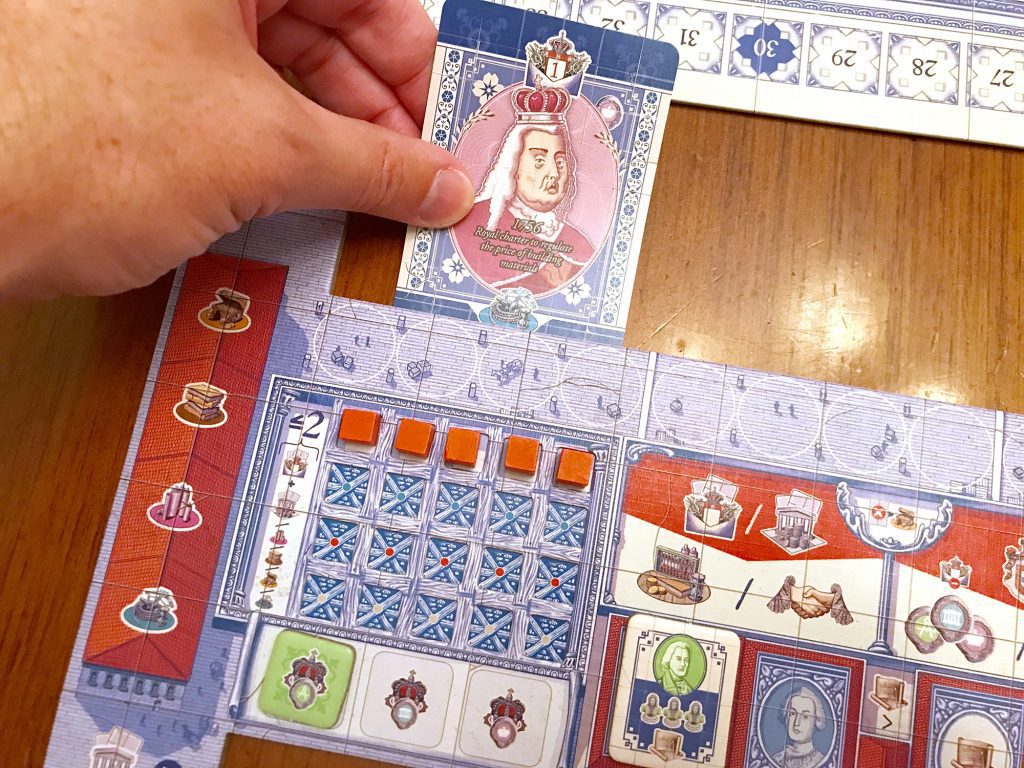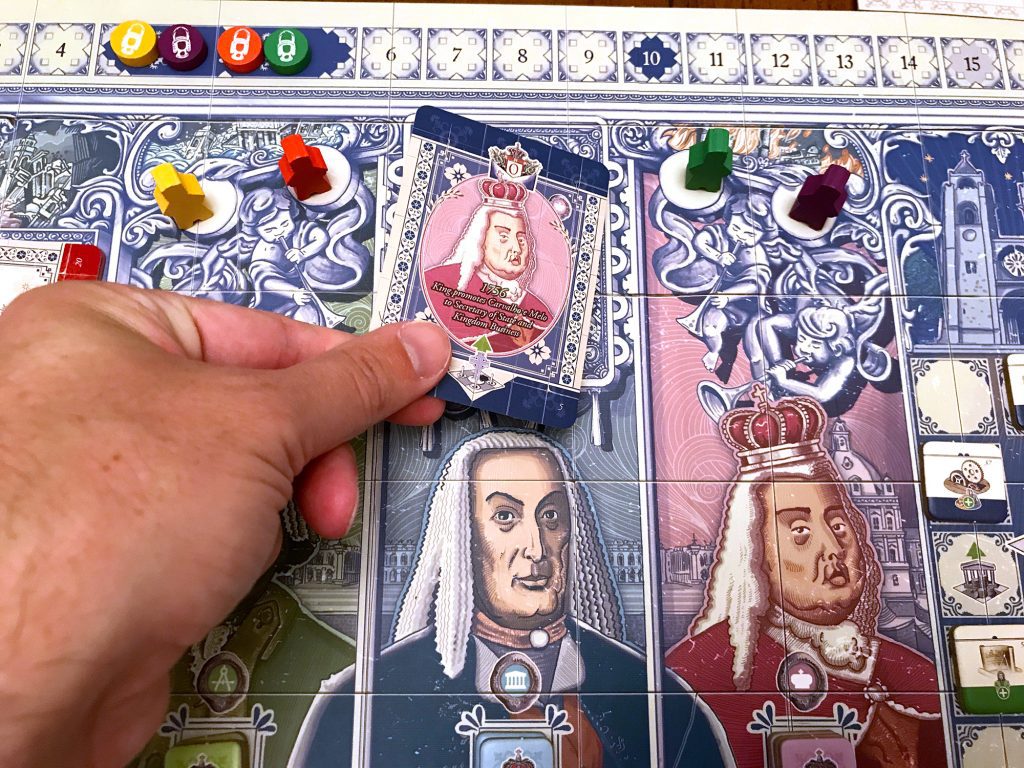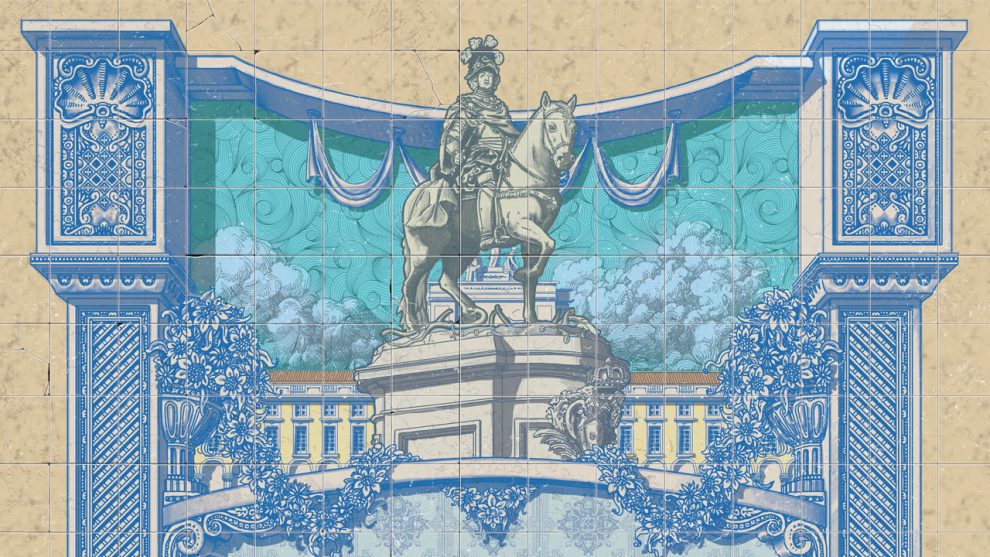Rebirth from Destruction
Earthquake. Tsunami. Fires.
While it may seem like I’m rattling off the current evening news, these three cataclysmic events struck the city of Lisbon in a triple-whammy of destruction in the year 1755. In order to quickly rebuild this once-thriving city, King Joseph I gave considerable power to the Prime Minister, known as the Marquis de Pombal, and his Master Builder, Manuel da Maia. Together, they devised a plan that involved destroying what remained of the city, clearing rubble, and using it to rebuild the city according to modern city design.

In Lisboa, by Vital Lacerda, you play the role of a lesser noble of Lisbon who uses influence and goods to meet with the Master Builder, the Prime Minister, and the King. You will take actions to rebuild the city, develop the economy, and eventually earn the most prized sign of nobility… Wigs. Yes, Wigs. Lookout LadyGaga, you’ve got nothing on the 18th century. The noble with the most wigs at the end of the game wins!

We Built This City
As a noble helping to rebuild the city of Lisbon, you will play the game over 2 acts which represent a 22 year span of Portuguese history. Each player has a board that will serve as their base for collecting goods, storing rubble that they clear from the city, docking ships that they build, and keeping stock of bonuses they gain from the church. Each player also has a supply of houses that claim buildings they construct, and officials that they deploy into the Nobles’ offices.
Lisboa uses a multi-purpose card action system to give players a number of interesting options to build their Wig-engine, and it’s not as mechanically complex as it first appears. You simply select one of 5 cards from your hand each turn and play it. Where you play it makes a huge difference and leads to branching available actions.
Play Your Cards Right And You’ll Be Fine
You can play a card into the tableau of your player board. This will help you gain more influence or give you some kind of economic bonus as you play the game. By adding the card to your tableau you then must either a) sell one or more of the four main goods (gold, books, cloth, or tools) on a ship that either you or another player owns (which generally gives you money), or b) you must trade one or two goods to the Nobles and take one of the actions they offer. These are called “state actions”, and they generally are less powerful actions, but necessary to give you the resources you need in your quest for to beat Gaga’s Wig collection.

Alternatively, if you don’t add the card to your player board you will instead play it on the main board. This signifies you are going directly to meet with either the King, the Marquis, or the Master Builder. You will spend influence instead of goods to muscle your way into their office and take Noble actions. These are more powerful and lead to the bigger scoring opportunities. You’ll get to build stores into the city, take “decrees” which give you end game scoring bonuses, and open public buildings. Constructing stores and public buildings will give you Wigs during the game, and usually grant end-game Wigs as well. If you aren’t meeting a Noble, you can use your card to “sponsor an event” which basically gives you a reward item or action that’s listed on the card.

Once you’ve played your card to your tableau or onto the board and taken the associated actions, you end your turn by drawing a new card into your hand from one of 4 stacks on the board. At a certain point, you will end the first act of the game, add new stacks of cards into the game which are generally more powerful and add even more interesting decisions, rewards, and actions to your hand.
Noble Impressions
If you’ve never played a Lacerda game before, you may feel overwhelmed at the amount of stuff there is to do. Or by the amount of stuff that’s just sitting on the table! I’m pretty sure you could almost rebuild an actual house from the number of components in the box. But just like Lacerda’s other games such as The Gallerist or Kanban, you are smartly given a stripped down decision tree each turn. You just get one card to play, and then pick one of two actions based off how you play your card. It will take a few plays for the player downtime to diminish as you learn the available actions.
Lisboa is a true Wig-salad at game end. In true Lacerda fashion, you will score for almost everything you do in the game. One thing I love about playing Vital Lacerda games is that he makes the work you’ve done while playing the game feel worth it. Buildings give you points, having decrees gives you points, having officials dedicated to buildings gives you points, collecting rubble gives you points. While you’re playing, you may not see your Wig marker moving much, but there are a lot of points hidden behind each action you’re taking. And it’s incredible how tight and close the games can be.
There are a few bookkeeping areas that can slow things a bit. Calculating the cost of stores is a math mini-game every time, and involves not only paying close attention to rubble still on the board, but making sure you check your tableau bonuses as well. And in-game scoring for stores and public buildings takes another set of calculations. If you like data, there are no less than five tracks to manage in the game (influence, treasury, value of goods, church, and scoring)! Thankfully, there is plenty of iconography scattered around the board to help you remember details of costs and rewards.

The player interaction is admittedly low. You’ll mainly only interfere with other players by selling goods onto their ships, building ships or buildings ahead of them, or placing officials into the Nobles court which makes the cost of influence go up for your opponents. Other than that, you’re mostly playing your own strategy However, replayability remains high. Because of the card-action mechanic, you will always have a different set of 5 cards in your hand, each with different bonuses and associated actions. You’ll need to adjust your strategy each game to make efficient use of the resources available to you as you play your cards. Each game of Lisboa will be a test of your strategic adaptability and action timing.
Labor of Love
Vital Lacerda’s love for Lisbon drips out of every bit of linen finish in this game. The rulebook not only contains full-color examples of key actions in the game, but also shares the historical theme behind the action. This provides reason behind what you’re physically doing in the game. If you love history, you will be immersed in the vast amount of detail found not only in the rulebook, but also on the playing cards themselves. The backs of the different cards even have the dates of what period those historical events took place.

The game art is turning heads, as Ian O’Toole’s art design recreates the classic Portuguese blue-tile (called Azulejos) look on the game board. It’s a massive white and blue masterpiece that’s ready to be mounted on the wall. (Don’t really mount it on the wall. The board is in fact mandatory to play the game.) And Lacerda’s thematic vision even gets down to the details of the board sections. The board artwork in the area where you build stores is literally the same configuration of what the city street reconstruction looked like in the late 1700s. So as you place buildings, you’re placing them on the actual city grid!

Wigging Out
As I played Lisboa, I began to see Vital Lacerda as the Master Builder. He takes abstract concepts and turns them into unique board game mechanics. While playing Lisboa, you’ll discover you’re not just playing a cube-pushing Euro; you are playing a city-rebuilding system that’s constructed through multiple avenues of interconnected actions. You’ll find yourself navigating through the twists, turns, and intersections of the game actions just like you’re traveling through the Baixa de Lisboa.
This game begs for you to mine it and explore the glory of Lisbon buried under complex avenues of strategy. While I was a huge fan of Vital Lacerda’s Kanban, Lisboa now has taken the Azulejo Throne of my heavy Euro collection. It plays smoothly with an incredibly deep and intriguing system to dig into on repeated plays. Lisboa feels both classic in its game mechanics and art, while at the same time fresh and modern in its implementation of theme and design. With a love for this city, Lacerda echoes the Nobles of the 18th century by crafting Lisboa into a work of art.
Make sure to check out the excellent official how to play video for Lisboa done by Paul Grogan of Gaming Rules Vids.












Add Comment